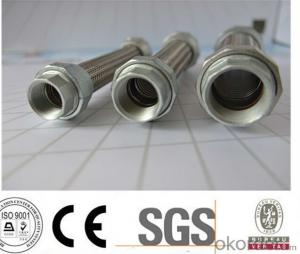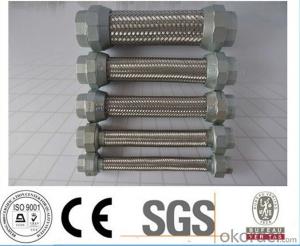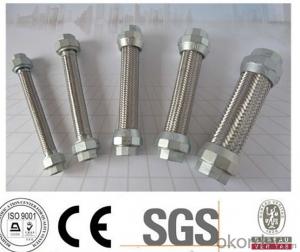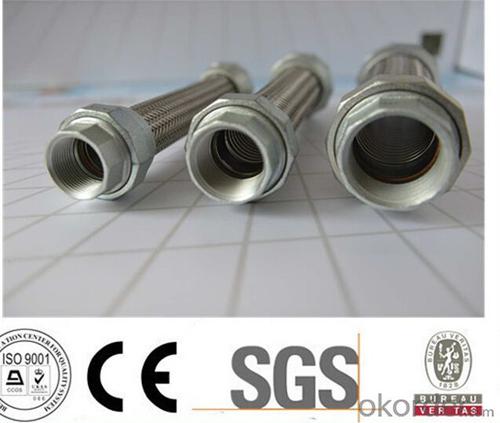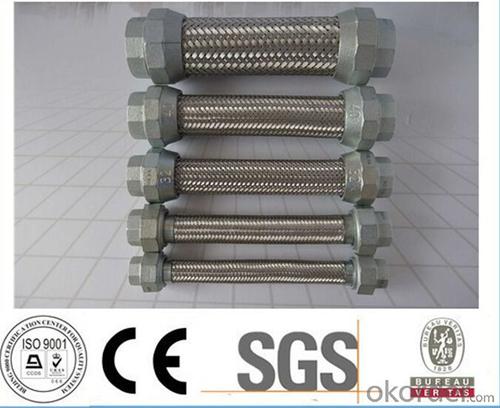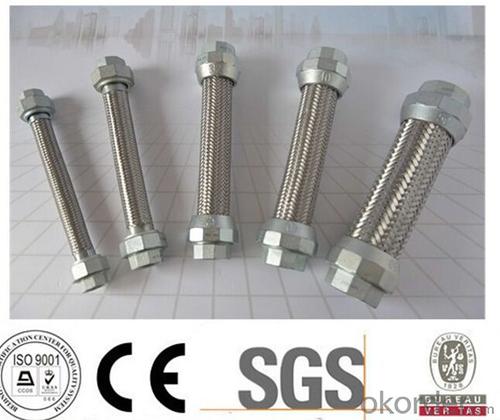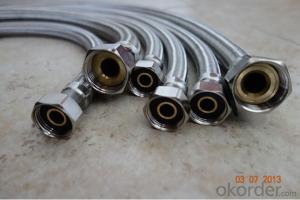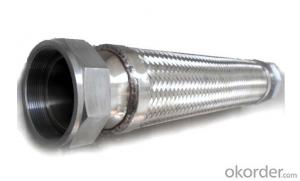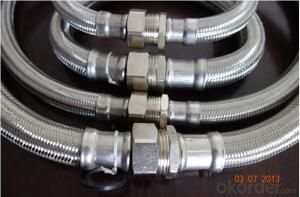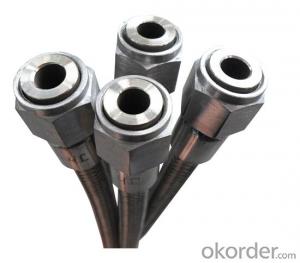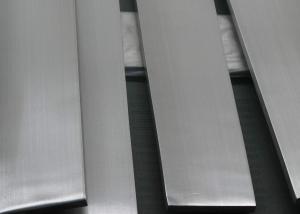Stainless Steel Braid Hose with 1/2'' Fittings
- Loading Port:
- Tianjin
- Payment Terms:
- TT OR LC
- Min Order Qty:
- 1000 pc
- Supply Capability:
- 100000 pc/month
OKorder Service Pledge
OKorder Financial Service
You Might Also Like
Specification
Stainless Steel Braid Hose with 1/2'' Fittings
Applications of Stainless Steel Braid Hose with 1/2'' Fittings:
--Refueling system
--Chemical and pharmaceutical industry
--Industrial hydraulic systems
--Air conditioners in industrial and construction –site vehicles
--Food and beverage industry
--Special and standard industrial applications
--Water and cleaning management
Features of Stainless Steel Braid Hose with 1/2'' Fittings:
1. )O. D.: 13-18MM 0.2-3M long
2. )Nut.: Nickel/Chrome Plated Brass (Zinc / Iron / Aluminum is available)
3. )Size Of Nut.: Female&Male 1/2''; 3/4''; 3/8''; 7/8''; 5/16'', and M10...
4. )Insert.: Brass (Zinc / Aluminum / Plastic is available)
5. )Inner tube.: Rubber/ EPDM/PVC
6. )Covered Material: Stainless Steel 201, 301, 304 /Aluminium Wire
7. )Working Pressure: 5Kg-15Kg
8. )Temperature: 0-92° C
9. )Quality Assurance: 3 years
RemarkAPPLICATION: HOUSEEHOLD WARE, BATHROOM WARE, SHOWER HOSE
PAYMENT: T/T, L/C
DELIVERY TIME: 20DAYS OR 30DAYS AFTER RECEIVED 30% DEPOSITS
MOQ: 5000PCS
ODM&OEM IS ACCEPTABLE
PackageInner: PP bag /Blister packing Outer: Carton box
Specifications of Stainless Steel Braid Hose with 1/2'' Fittings:
NO | I.D | Refer to O.D | Working pressure | Burst pressure | approximate Weight | |||||
(inch) | (mm) | (inch) | (mm) | MPa | Psi | MPa | Psi | kg/m | lbs/ft | |
1 | 1/8 | 3.2±0.2 | 0.35 | 9±0.3 | 2.06 | 300 | 8.27 | 1200 | 0.078 | 0.12 |
2 | 5/32 | 4±0.2 | 0.4 | 10±0.3 | 2.06 | 300 | 8.27 | 1200 | 0.092 | 0.14 |
3 | 3/16 | 4.8±0.2 | 0.43 | 11±0.3 | 2.06 | 300 | 8.27 | 1200 | 0.108 | 0.16 |
4 | 1/4 | 6.3±0.3 | 0.5 | 12.7±0.3 | 2.06 | 300 | 8.27 | 1200 | 0.134 | 0.2 |
5 | 5/16 | 8.0±0.3 | 0.56 | 14±0.3 | 2.06 | 300 | 8.27 | 1200 | 0.147 | 0.22 |
6 | 3/8 | 9.5±0.3 | 0.63 | 16±0.4 | 2.06 | 300 | 8.27 | 1200 | 0.182 | 0.27 |
7 | 15/32 | 12±0.3 | 0.75 | 19±0.5 | 2.06 | 300 | 8.27 | 1200 | 0.238 | 0.35 |
8 | 1/2 | 12.7±0.4 | 0.78 | 20±0.5 | 2.06 | 300 | 8.27 | 1200 | 0.262 | 0.39 |
9 | 5/8 | 16±0.4 | 0.94 | 24±0.5 | 1.03 | 150 | 4.12 | 600 | 0.351 | 0.52 |
10 | 3/4 | 19±0.4 | 1.13 | 28.8±0.5 | 1.03 | 150 | 4.12 | 600 | 0.515 | 0.77 |
11 | 1 | 25.4±0.5 | 1.38 | 35±0.6 | 1.03 | 150 | 4.12 | 600 | 0.637 | 0.95 |
Images of Stainless Steel Braid Hose with 1/2'' Fittings:
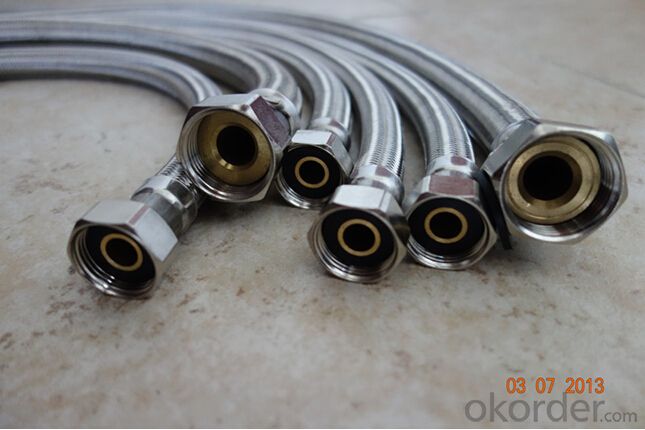
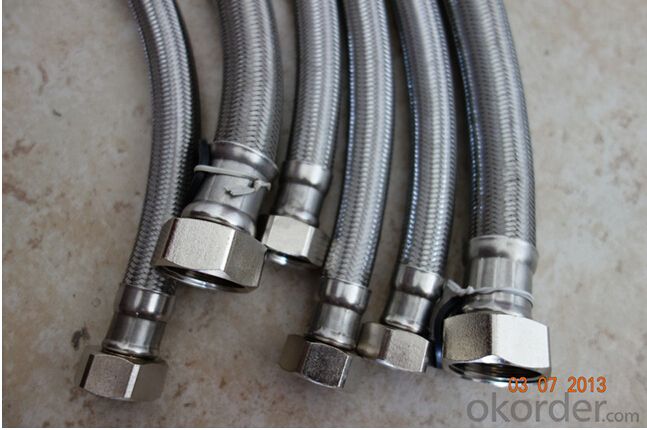
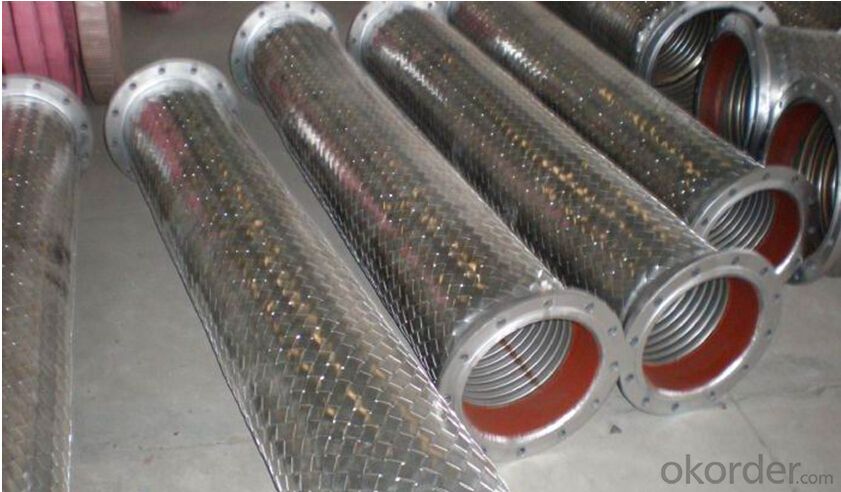
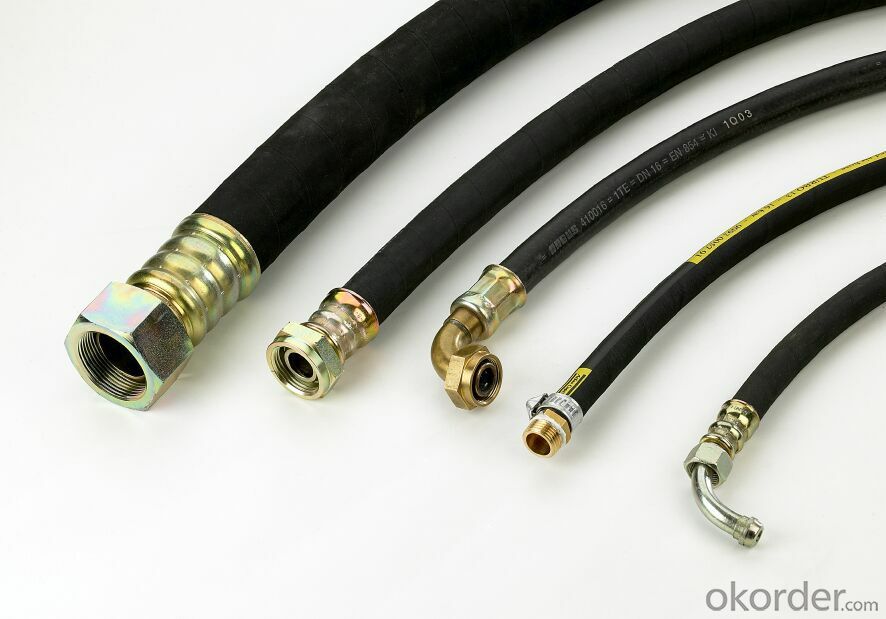
Package of Stainless Steel Braid Hose with 1/2'' Fittings:
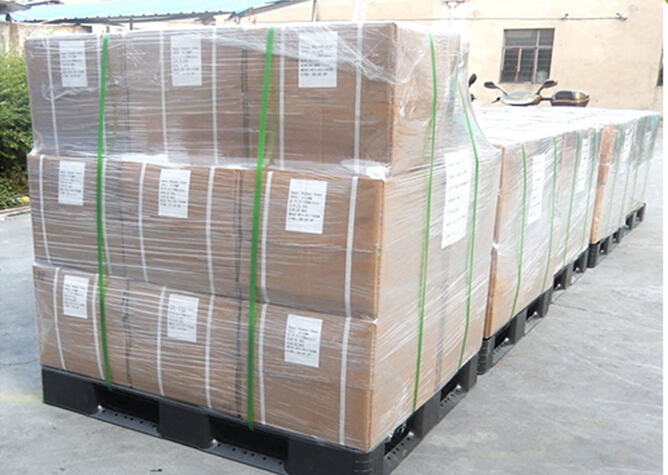

FAQ of Stainless Steel Braid Hose with 1/2'' Fittings:
Who we are:
Answer: We CNBM is a Chinese state-owned enterprise ranked 267th among the Global Fortune 500, as the largest building materials company,we have over 300 affiliated companies,and so many production lines and branch office distribute in China.
2. About our quality:
Answer: Every product needs to be quality proved before shipping.
3. About our service:
Answer: We could gurantte that we can reply you in 2 working hours.
- Q: Can stainless steel pipes be used for wastewater treatment systems?
- Yes, stainless steel pipes can be used for wastewater treatment systems. Stainless steel is a highly durable and corrosion-resistant material, making it an ideal choice for pipes in harsh environments such as wastewater treatment plants. These pipes can withstand the corrosive nature of wastewater, including the presence of chemicals and different pH levels. Stainless steel pipes also have a smooth surface, which helps to minimize the accumulation of waste and bacteria, ensuring the efficient flow of wastewater through the system. Additionally, stainless steel is easy to clean and maintain, making it a cost-effective and reliable choice for wastewater treatment systems.
- Q: Can stainless steel pipes be polished?
- Absolutely! It is entirely possible to polish stainless steel pipes. Stainless steel, known for its versatility and durability, can undergo a polishing process to elevate its visual appeal and achieve a smoother texture. This involves employing abrasive substances like sandpaper or polishing compounds to eliminate imperfections, scratches, or oxidation from the surface. By engaging in this method, not only does it enhance the pipes' aesthetic allure, but it also safeguards against corrosion and extends their lifespan. Polished stainless steel pipes find widespread application across industries such as architecture, interior design, automotive, and food processing, where a pristine and polished appearance is sought after.
- Q: Are stainless steel pipes suitable for power plant systems?
- Yes, stainless steel pipes are suitable for power plant systems. They offer excellent corrosion resistance, high strength, and durability, making them ideal for transporting various fluids and gases in power plant environments. Additionally, stainless steel pipes can withstand high temperatures and pressures, ensuring reliable and efficient operations in power generation facilities.
- Q: What is the average lead time for manufacturing stainless steel pipes?
- The average lead time for manufacturing stainless steel pipes can vary depending on several factors such as the complexity of the design, quantity required, and the manufacturer's production capacity. However, on average, it can range from a few weeks to a couple of months.
- Q: Are stainless steel pipes resistant to chloride stress corrosion cracking?
- Yes, stainless steel pipes are generally resistant to chloride stress corrosion cracking due to the high levels of chromium and nickel present in their composition. These elements form a protective oxide layer on the surface of the pipes, preventing the penetration of chlorides and reducing the risk of stress corrosion cracking. However, certain grades of stainless steel may be more susceptible to this type of corrosion in certain environments, so it is important to select the appropriate stainless steel grade for the specific application.
- Q: Can stainless steel pipes be fabricated?
- Indeed, it is possible to fabricate stainless steel pipes. Stainless steel possesses remarkable versatility, enabling it to be effortlessly manipulated and formed into different dimensions and configurations. By employing fabrication techniques like cutting, bending, welding, and threading, stainless steel pipes can be tailored to meet specific demands. These pipes find application across a wide range of industries, encompassing construction, automotive, oil and gas, plumbing, and more. The corrosion resistance and durability inherent in stainless steel render it a perfect candidate for fabricating pipes that must endure rigorous environmental circumstances.
- Q: How do stainless steel pipes compare to concrete pipes?
- Stainless steel pipes and concrete pipes each have their own advantages and disadvantages, and their suitability for specific applications may vary. Stainless steel pipes are known for their durability, corrosion resistance, and high strength-to-weight ratio. They can withstand extreme temperatures, making them ideal for applications that involve high-pressure fluids or gases, such as in the oil and gas industry. Stainless steel pipes are also commonly used in food processing, chemical plants, and wastewater treatment facilities due to their hygienic properties and resistance to chemicals. Additionally, stainless steel pipes have a smooth interior surface, which reduces friction and allows for efficient fluid flow. On the other hand, concrete pipes are known for their strength, longevity, and resistance to external loads. They are commonly used in sewer systems, stormwater drainage, and culverts due to their ability to withstand heavy traffic loads and high groundwater pressures. Concrete pipes are also fire-resistant and provide excellent insulation, making them suitable for applications where fire protection is crucial. In terms of cost, stainless steel pipes are generally more expensive than concrete pipes. However, stainless steel pipes require minimal maintenance and have a longer lifespan, which can offset the initial cost. Concrete pipes, although cheaper, may require more frequent repairs and have a shorter lifespan. Ultimately, the choice between stainless steel pipes and concrete pipes depends on the specific requirements of the project, including factors such as the intended application, environmental conditions, budget, and lifespan expectations. Consulting with a professional engineer or specialist in pipe materials can help ensure the selection of the most appropriate pipe material for a particular project.
- Q: Can stainless steel pipes be insulated with polyurethane?
- Yes, stainless steel pipes can be insulated with polyurethane. Polyurethane insulation is commonly used for both thermal and acoustic insulation in various industries, including plumbing and HVAC systems. It offers excellent thermal conductivity properties and low moisture absorption, making it an ideal choice for insulating stainless steel pipes. Polyurethane insulation can be applied as a foam or in the form of pre-insulated pipe sections. It provides effective insulation by reducing heat loss or gain, preventing condensation, and improving energy efficiency. Additionally, polyurethane insulation is durable, lightweight, and resistant to corrosion, making it a suitable choice for insulating stainless steel pipes in various applications.
- Q: How do stainless steel pipes compare to nickel alloy pipes?
- Both stainless steel pipes and nickel alloy pipes are widely utilized in various industries for their corrosion resistance properties, high strength, and durability. Nevertheless, there are noteworthy distinctions between these two materials that should be taken into account during comparisons. A primary difference lies in their composition. Stainless steel pipes consist mainly of iron and chromium, with additional elements like nickel and molybdenum added to enhance corrosion resistance. On the other hand, nickel alloy pipes are primarily composed of nickel, with the inclusion of other elements such as chromium, iron, and molybdenum. Regarding corrosion resistance, both stainless steel and nickel alloy pipes offer exceptional protection against corrosion. However, nickel alloy pipes are recognized for providing superior resistance to a broader range of corrosive environments, including highly acidic and alkaline conditions. This makes nickel alloy pipes more suitable for applications requiring extreme corrosion resistance, such as in chemical processing plants. Another factor to consider is the mechanical strength of the pipes. Stainless steel pipes are known for their high strength, making them suitable for applications requiring structural integrity and the ability to withstand high-pressure environments. Conversely, nickel alloy pipes offer even greater strength and toughness, making them ideal for applications involving high temperatures and extreme conditions, such as in the oil and gas industry. Cost is another aspect to consider when comparing stainless steel and nickel alloy pipes. Stainless steel pipes are generally more cost-effective and readily available compared to nickel alloy pipes. Nickel alloy pipes tend to be more expensive due to the higher cost of nickel and other alloying elements used in their production. Therefore, the choice between stainless steel and nickel alloy pipes often depends on the specific requirements of the application and budget constraints. In conclusion, both stainless steel pipes and nickel alloy pipes offer excellent corrosion resistance and mechanical strength. While stainless steel pipes are more cost-effective and commonly used in various applications, nickel alloy pipes provide superior corrosion resistance and strength in extreme conditions. Therefore, the selection between these two materials depends on the specific needs and requirements of the application at hand.
- Q: Stainless steel pipe pickling ratio
- Usage: used for contaminant removal of various types of stainless steel parts, sheet metal surface and its equipment rust, oxide skin, after welding of yellow blue black spot welding, a silver white metal surface cleaning, and surface passivation, corrosion resistance of stainless steel.
Send your message to us
Stainless Steel Braid Hose with 1/2'' Fittings
- Loading Port:
- Tianjin
- Payment Terms:
- TT OR LC
- Min Order Qty:
- 1000 pc
- Supply Capability:
- 100000 pc/month
OKorder Service Pledge
OKorder Financial Service
Similar products
Hot products
Hot Searches
Related keywords
